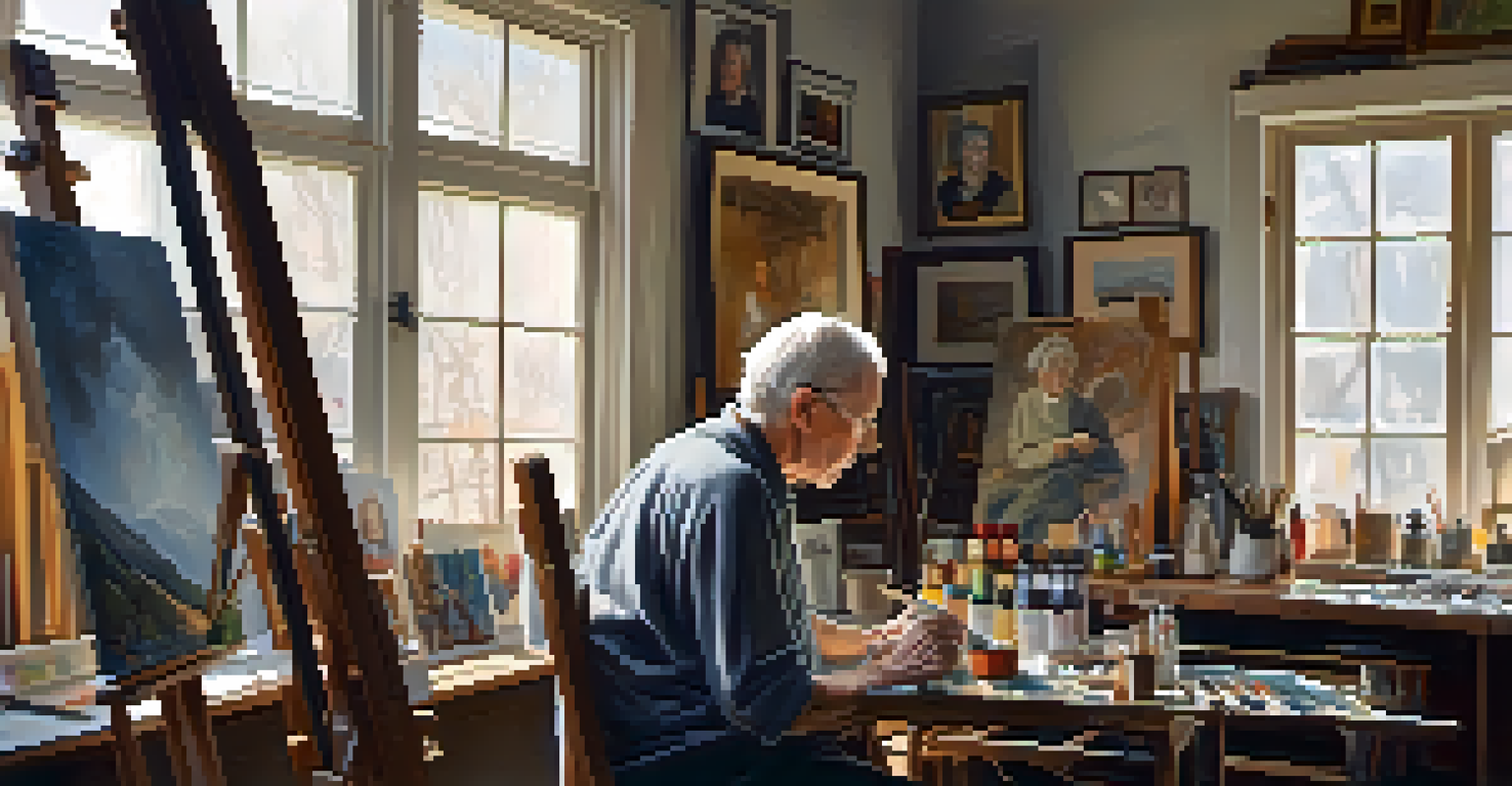A Journey Through the Life of Rembrandt: Master of Light and Shadow

Rembrandt's Early Life and Influences on His Art
Rembrandt Harmenszoon van Rijn was born in 1606 in Leiden, Netherlands. Growing up in a family of millers, he was surrounded by the beauty of the Dutch landscape, which deeply influenced his artistic vision. His early exposure to art came from studying under various local artists, notably Jacob van Swanenburg, who introduced him to chiaroscuro—the technique of using light and shadow to create depth.
Every artist was first an amateur.
By his late teens, Rembrandt was already making waves in the art world, thanks to his unique style. He moved to Amsterdam, where the bustling city provided new opportunities and inspirations. The vibrant art market allowed him to experiment with different themes, including portraits and historical scenes, setting the stage for his future masterpieces.
Rembrandt's formative years were crucial in shaping his artistic identity. His ability to capture human emotions through expressive faces and dynamic compositions set him apart from his contemporaries. It was during this time that he began to develop his signature use of light, which would later become a hallmark of his work.
The Rise to Fame: Masterpieces and Recognition
After establishing himself in Amsterdam, Rembrandt quickly gained recognition for his striking portraits. His innovative use of light and shadow not only brought his subjects to life but also conveyed their inner emotions. Works like 'The Night Watch' and 'The Anatomy Lesson of Dr. Nicolaes Tulp' showcased his ability to blend narrative with technical skill, captivating audiences.

During this period, he enjoyed considerable success, attracting a wealthy clientele. His portraits were highly sought after, as he had a remarkable ability to capture the essence of his sitters. This made Rembrandt a household name in the art circles of the time, but fame also came with its challenges, including financial pressures and personal losses.
Rembrandt's Artistic Influences
Rembrandt's early life in the Dutch landscape and his studies under local artists shaped his unique artistic vision.
His career peak in the 1640s and 50s was marked by a flurry of creativity. Rembrandt experimented with various styles and subject matters, producing iconic works that would later define his legacy. Yet, despite his success, the artist faced significant hardships that would test his resilience.
The Personal Struggles: Tragedy and Transformation
As Rembrandt's career flourished, his personal life took a tumultuous turn. He faced the heart-wrenching loss of his beloved wife, Saskia, who passed away in 1642. This tragedy deeply affected him, leading to a period of mourning reflected in his art, as he began to explore themes of loss and vulnerability in a more profound way.
Art is not freedom from discipline, but disciplined freedom.
Financial troubles soon followed, largely due to his extravagant lifestyle and poor investments. Despite his artistic genius, Rembrandt struggled to manage his finances, which ultimately resulted in bankruptcy in 1656. This decline forced him to sell many of his possessions, but it also provided him with a fresh perspective on life and art.
These challenges prompted a significant evolution in Rembrandt's work. He shifted from grand historical scenes to more intimate portraits and biblical themes, capturing the human experience with empathy and depth. This transformation marked a new chapter in his artistic journey, allowing him to delve deeper into the complexities of the human soul.
The Mastery of Light and Shadow: Techniques and Styles
Rembrandt's mastery of light and shadow, known as chiaroscuro, set him apart from other artists of his time. He employed dramatic contrasts to highlight the emotional weight of his subjects, creating a sense of three-dimensionality. This technique not only added depth to his paintings but also enhanced their narrative quality, drawing viewers into the story.
He often used a limited palette, focusing on earthy tones to create a warm, intimate atmosphere. This choice allowed the play of light to become the central focus, guiding the viewer's eye to the essential details of the composition. Rembrandt's ability to manipulate light made his paintings feel alive, with a dynamic energy that resonated with audiences.
Struggles and Artistic Evolution
Despite achieving fame, personal tragedies and financial difficulties led Rembrandt to explore deeper themes in his art.
In addition to chiaroscuro, Rembrandt's brushwork contributed to the uniqueness of his style. His spontaneous, textured strokes gave his works a sense of immediacy and realism. This technique not only showcased his technical prowess but also conveyed the emotional intensity that characterized his later works.
Influence on Future Generations of Artists
Rembrandt's impact on the art world extends far beyond his lifetime, influencing countless artists across generations. His innovative techniques in light and shadow inspired the Impressionists and later movements, who sought to capture the fleeting effects of light in their works. Artists like Claude Monet and Vincent van Gogh often cited Rembrandt as a pivotal influence in their artistic development.
Moreover, his ability to convey deep emotion and humanity in his subjects resonated with many artists who followed. The psychological depth and realism in his portraits encouraged others to explore the complexities of human expression. This legacy of emotional authenticity continues to be a cornerstone of modern art.
Rembrandt's art remains a touchstone for those studying the evolution of painting techniques. His works are still celebrated in museums worldwide, drawing new audiences who are captivated by his mastery. Through exhibitions, retrospectives, and academic discourse, Rembrandt's influence endures, reminding us of the timeless power of art.
Rembrandt's Legacy: A Timeless Icon of Art
Rembrandt passed away in 1669, leaving behind a vast body of work that continues to inspire and captivate. His paintings, etchings, and drawings are celebrated for their emotional depth and technical brilliance. While he faced personal and financial struggles, his artistic legacy has only grown, solidifying his status as one of the greatest painters in history.
Today, Rembrandt's influence can be seen in various forms of visual art, from contemporary painting to photography. His explorations of light, shadow, and human emotion resonate with artists and audiences alike, proving that his work transcends time. Exhibitions showcasing his masterpieces are met with enthusiasm, attracting art lovers eager to experience his genius firsthand.
Timeless Legacy in Art
Rembrandt's mastery of light and emotion continues to inspire countless artists and captivates audiences worldwide.
In reflecting on his life and work, we recognize Rembrandt not just as a master painter but as a storyteller who captured the human experience. His ability to convey emotion through art has left an indelible mark, ensuring that his legacy will continue to inspire future generations.
Visiting Rembrandt's Works Today: Museums and Exhibits
For those eager to witness Rembrandt's genius up close, numerous museums around the world house his masterpieces. The Rijksmuseum in Amsterdam boasts the largest collection of his works, including 'The Night Watch' and several stunning portraits. Visiting this museum offers a unique opportunity to appreciate the intricate details and masterful techniques that define his art.
Many art institutions also hold temporary exhibitions featuring Rembrandt's works, allowing for a broader exploration of his influence. These exhibits often include pieces from private collections or lesser-known works, providing fresh insights into his artistic journey. Attending these exhibitions can be a transformative experience, deepening one's appreciation for his contributions to art.

In addition to physical visits, digital platforms are increasingly showcasing Rembrandt's works. Virtual tours and online exhibitions make it possible for art enthusiasts to explore his masterpieces from the comfort of their homes. This accessibility ensures that his legacy continues to reach a global audience, inspiring future generations to appreciate the beauty and complexity of his art.